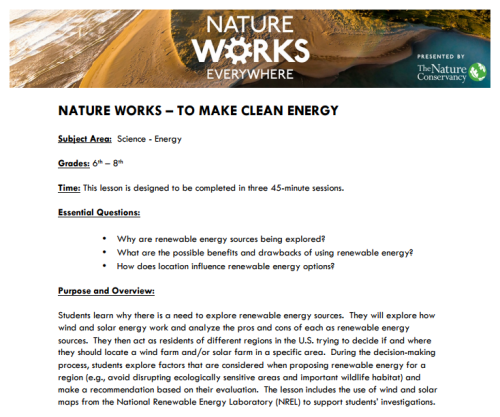Our need for energy is undeniable–we use it to fuel our cars, start our computers and mobile devices, power the lights and other household appliances in our homes, and of course, to power our classrooms!
The problem that looms ahead of us is this: How can we supply our growing need for energy without harming the environment?
The answer: renewable energy sources such as sunlight and wind. And this year, the Nature Conservancy has arranged a virtual field trip with scientist Alex Wegmann to the Palmyra Atoll and the Mojave Desert to learn more about how we can harness renewable energy.

How does the virtual field trip work?
- Who:geared for grades 3-8
- Where: live on YouTube
- When: May 20th, 2016, from 1:00-1:45 pm EST
- How to join: Register hereto get the viewing link
What if that date and time don’t work for my class?
If you can’t watch it on the afternoon of May 20th, register anyway to get the viewing link which you can use to show the trip to your class anytime after the live event has concluded. The virtual field trip will also be optimized and posted at a later date on The Nature Conservancy website and hosted on Vimeo. Vimeo links will also be sent to everyone who registered once it they’re ready.
What places do students get to visit during the virtual trip?
The first stop of the trip is Palmyra Atoll, a wildly remote cluster of islands atop coral reefs and teeming with animal life where scientists have figured out ways to power the entire island almost exclusively through renewable energy sources. 1,000 miles south of Hawaii, Palmyra Atoll is one of the most spectacular marine wilderness areas on Earth. The Nature Conservancy actually bought Palmyra in 2000 from the Fullard-Leo family, who had previously turned down offers to have the atoll used as a nuclear waste site and a casino.
Today, Palmyra is a national marine monument, and the Conservancy and the U.S. Fish & Wildlife Service are working in partnership to protect it. Through the Palmyra Atoll Research Consortium, it is also being developed as a center for scientific study. What we can learn at Palmyra—about global climate change, coral reefs, marine restoration and invasive species—promises to inform conservation strategies for island ecosystems throughout the Pacific and around the world.
The second stop is the Mojave Desert–home to rattlesnakes, tortoises, bats, and coyotes– to check out massive solar panel installations that are working to power large cities.
Students may think the desert is empty, but it’s actually teeming with activity and inhabitants: the Mojave shelters a huge range of plants and animals. Simultaneously, its 20 million acres offer up a multitude of opportunities (from recreation to ranching, from mining to military training) for people.
The desert’s natural benefits support life in California in so many ways, but they’re both finite and fragile. That is why The Nature Conservancy is applying its Development by Design approach to care for the desert. Their goal is to encourage the development of clean energy, which is vital to California’s future, while protecting the desert’s unique landscapes and ecology.
What will students learn?
Throughout the trip, you and your class will learn about innovative methods for capturing safe, renewable energy that our planet truly needs now.
The content is aligned with the Next Generation Science Standards and is geared toward grades 3-8, but all viewers are welcome!
How do I integrate the field trip with my curriculum?
After the field trip, teachers can do a follow-up lesson on renewable energy with this lesson planthat The Nature Conservancy has prepared. The lesson can be downloaded in both PDF and Word formats.

The lesson plan also comes with a video about making clean energy. It explores two of the most important renewable energy sources, solar and wind power (which, unlike their nonrenewable counterparts like fossil fuels, coal, and natural gas, can quickly replenish themselves and are usually available in a never-ending supply.)
Nature Works – To Make Clean Energy from The Nature Conservancy on Vimeo.
Remember: the virtual field trip will be held live on YouTube on the 20th of May from 1:00-1:45 pm EST. Register here to get the viewing link. Happy traveling!
Disclosure: This post has been sponsored through a partnership with WeAreTeachers and The Nature Conservatory.

Angela Watson
Founder and Writer
Sign up to get new Truth for Teachers articles in your inbox
Discussion
OR

Join our
community
of educators
If you are a teacher who is interested in contributing to the Truth for Teachers website, please click here for more information.
















Hi! I teach 4th grade in Colorado and was interested in doing a SKYPE session with our kids similar to this one. Are you planning on doing this again? Is there a link that we can still view this virtual field trip?
Any information/help would be great.
Thanks for your help.
Kristian Odegaard
kodegaard@dcsdk12.org
Hi there,
I am a primary school teacher in Stockholm and we are doing a unit on Energy. Is it possible to still get a link to show them this virtual field trip, by any chance?